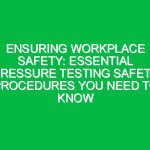The offshore drilling industry, vital for meeting the global demand for oil and gas, operates in some of the most challenging and hazardous environments. Ensuring the safety of personnel, protecting the environment, and maintaining operational integrity are paramount. This article delves into the essential strategies for achieving Health, Safety, and Environment (HSE) excellence in offshore drilling operations. By integrating these practices, companies can not only safeguard their workforce and the environment but also enhance operational efficiency and reputation.
Understanding the Risks in Offshore Drilling
Before diving into the strategies for HSE excellence, it’s crucial to understand the inherent risks associated with offshore drilling. These include, but are not limited to, blowouts, spills, occupational hazards, and environmental impacts. Recognizing these risks is the first step towards mitigating them effectively.
Strategies for HSE Excellence in Offshore Drilling
To maximize safety and achieve HSE excellence in offshore drilling operations, companies must adopt a comprehensive and proactive approach. This involves several key strategies, each contributing to the overall safety culture and operational integrity of the organization.
1. Implementing Robust Safety Management Systems
A robust Safety Management System (SMS) is the cornerstone of HSE excellence. It provides a structured framework for managing safety risks, encompassing policy, objectives, planning, responsibilities, procedures, and performance monitoring. An effective SMS ensures that safety practices are integrated into every aspect of operations, from planning to execution.
2. Fostering a Strong Safety Culture
A strong safety culture is characterized by shared values, attitudes, and practices that prioritize safety above all else. It involves the commitment of everyone in the organization, from top management to the frontline workforce. Fostering a strong safety culture requires continuous education, open communication, and the empowerment of employees to report unsafe conditions without fear of reprisal.
3. Investing in Training and Competency Development
Ensuring that all personnel are adequately trained and competent is essential for safe operations. This includes not only technical skills but also safety awareness and emergency response capabilities. Regular training programs, drills, and competency assessments help maintain a high level of preparedness and proficiency among the workforce.
4. Leveraging Technology for Safety Enhancements
Advancements in technology offer significant opportunities to enhance safety in offshore drilling operations. This includes real-time monitoring systems, automation, and remote-operated vehicles (ROVs) that can reduce human exposure to hazardous conditions. Additionally, data analytics and predictive modeling can help identify potential risks before they escalate into incidents.
5. Conducting Rigorous Risk Assessments and Audits
Risk assessments and audits are critical tools for identifying and mitigating safety risks. These should be conducted regularly and involve a thorough examination of all aspects of operations, including equipment, procedures, and environmental conditions. The findings should be used to inform continuous improvement efforts.
6. Ensuring Effective Emergency Preparedness and Response
Despite the best preventive measures, emergencies can still occur. Therefore, having an effective emergency preparedness and response plan is crucial. This includes clear protocols for evacuation, search and rescue, spill response, and medical emergencies. Regular drills should be conducted to ensure that all personnel are familiar with the procedures and can respond effectively in a real emergency.
7. Promoting Environmental Stewardship
Protecting the environment is an integral part of HSE excellence in offshore drilling. This involves minimizing the environmental footprint of operations through measures such as waste reduction, spill prevention, and the use of environmentally friendly technologies. Companies should also be prepared to respond swiftly and effectively to minimize the impact of any environmental incidents.
Conclusion: The Path to HSE Excellence
Achieving HSE excellence in offshore drilling operations requires a multifaceted approach that integrates safety management, culture, training, technology, risk assessment, emergency preparedness, and environmental stewardship. By adopting these strategies, companies can not only ensure the safety and well-being of their workforce and protect the environment but also enhance operational efficiency and reputation. The journey towards HSE excellence is ongoing, demanding continuous commitment, evaluation, and improvement. However, the rewards in terms of reduced risks, improved performance, and sustainability are well worth the effort.
Summary of Key Points
- Understanding the inherent risks in offshore drilling is the first step towards mitigating them.
- Implementing a robust Safety Management System (SMS) is crucial for managing safety risks effectively.
- Fostering a strong safety culture involves the commitment of the entire organization.
- Training and competency development are essential for ensuring the safety and preparedness of the workforce.
- Leveraging technology can significantly enhance safety in offshore drilling operations.
- Regular risk assessments and audits are vital for identifying and mitigating safety risks.
- Effective emergency preparedness and response are crucial for managing incidents.
- Environmental stewardship is an integral part of HSE excellence in offshore drilling.
By embracing these strategies, companies in the offshore drilling industry can achieve HSE excellence, safeguarding their most valuable assets—their people and the environment—while maintaining operational integrity and efficiency.


